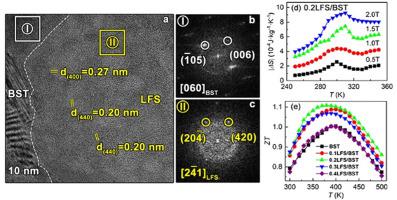Journal of Materiomics ( IF 9.4 ) Pub Date : 2021-02-26 , DOI: 10.1016/j.jmat.2021.02.013 Lin Xing , Wenjun Cui , Xiahan Sang , Fengxia Hu , Ping Wei , Wanting Zhu , Xiaolei Nie , Qingjie Zhang , Wenyu Zhao

|
Incorporating magnetic nanoparticles in thermoelectric (TE) materials introduce magnetic interfaces with additional electron and phonon scattering mechanism for high TE performance. However, the influence of heterogeneous interfaces between magnetic nanoparticles and TE matrix on electronic and thermal transport remains elusive in the thermo-electric-magnetic nanocomposites. Here, using p-type TE material Bi0·3Sb1·7Te3 (BST) as matrix and magnetocaloric (MC) material La(Fe0·92Co0.08)11.9Si1.1 (LFS) nanoparticles as a second phase, TE/MC nanocomposites xLFS/BST (x = 0.1%, 0.2%, 0.3% and 0.4%) were synthesized using spark plasma sintering method. The atomic-resolution interfacial structures demonstrate that Te vacancies originating from LFS-BST interfacial reaction decreases the hole concentration of the LFS/BST nanocomposites and enhances the Seebeck coefficient. The LFS/BST nanocomposites exhibit lower thermal conductivity due to enhanced phonon scattering by interfaces and defects. All the nanocomposites have higher ZT than BST matrix, with 0.2%LFS/BST nanocomposite achieving highest ZT = 1.11 at 380 K. At working current 1.4 A, the device fabricated using 0.2%LFS/BST nanocomposite achieves maximal cooling temperature 4.9 K, which is 58% higher than the matrix. Moreover, the MC properties are retained in all the nanocomposites, which make them a promising candidate to achieve high TE performance and dual TE/MC properties for future applications.
中文翻译:

包含磁热 LaFeSi 纳米颗粒的 BiSbTe 热电磁纳米复合材料中增强的热电性能和原子分辨率界面结构
在热电 (TE) 材料中加入磁性纳米粒子会引入具有额外电子和声子散射机制的磁性界面,以实现高热电性能。然而,磁性纳米粒子和 TE 基质之间的异质界面对电子和热传输的影响在热-电-磁性纳米复合材料中仍然难以捉摸。这里,使用p型TE材料Bi 0·3 Sb 1·7 Te 3 (BST)作为基体和磁热(MC)材料La(Fe 0·92 Co 0.08 ) 11.9 Si 1.1 (LFS)纳米颗粒作为第二相, TE/MC 纳米复合材料x LFS/BST ( x = 0.1%、0.2%、0.3% 和 0.4%) 是使用放电等离子烧结法合成的。原子分辨率界面结构表明,源自 LFS-BST 界面反应的 Te 空位降低了 LFS/BST 纳米复合材料的空穴浓度并提高了塞贝克系数。由于界面和缺陷增强了声子散射,LFS/BST 纳米复合材料表现出较低的热导率。所有纳米复合材料的ZT 均高于 BST 基体,0.2%LFS/BST 纳米复合材料的ZT最高 在 380 K 时 = 1.11。在 1.4 A 的工作电流下,使用 0.2% LFS/BST 纳米复合材料制造的器件达到最大冷却温度 4.9 K,比基体高 58%。此外,所有纳米复合材料都保留了 MC 特性,这使它们成为实现高 TE 性能和双 TE/MC 特性以供未来应用的有希望的候选者。


























 京公网安备 11010802027423号
京公网安备 11010802027423号